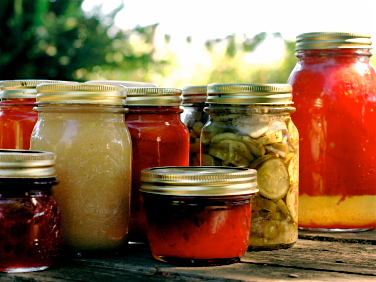
reference-image, l
(article, Jennifer Savage)
[%pageBreakSettings nobreak=true] In June, our 10-month-old daughter finished our last bag of frozen peaches. The same week, my husband and I finished our last jar of the tomato sauce we’d canned, bleary-eyed, last fall. By then, our freezer seemed to have limitless space and our shelves felt bare. Last season’s food was gone, but the strawberries were coming in at the farm down the road. In a few weeks, the cherries would be ripe at the farm by the lake and the raspberries would be ready in our neighbor’s patch. Slowly, our own garden would start to produce. In early September, we’ll pull tomatoes, onions, potatoes, carrots, and squash. We’ll pick basil. We’ll pick beans. We’ll freeze, we’ll dry, we’ll can. It’s a season in our house, the putting away of food. It begins in July with raspberries and ends in October with apples. Every year it sneaks up on me and ends too soon. I find myself collecting glass jars of all sizes from yard sales, thrift stores, and various shelves in my kitchen. I inspect the seals of thin metal lids I find at the bottom of drawers; I force screwtop bands that time has bent into awkward ovals back into circles. I count the jars, the lids, the bands. I try to guess how many pints I’ll need, how many quarts, how many tiny jars for jam and apple butter. [%image canning float=left width=400 credit="Photo: iStockphoto/elenaray" caption="Sunshine bottled in a jar."] I wash each jar by hand in hot, soapy water. I wash lids, I wash bands. I line the jars up on clean kitchen towels to dry: jam jars, quarts, wide-mouth pints. I survey the jars, clean and warm to the touch from their hot-water soak. I like the possibility of them. As the heat of a July afternoon fills my kitchen, I remember standing here a year ago. Last year, as the growing season was coming to an end, I could only wash a few jars before I had to prop up my swollen ankles. I could see my distended feet over the rise of a belly stretched tight from a baby that was running out of room. From where I sat, I could also see the scatter of jars in my kitchen, the disorderliness of them and the slow slipping away of any hopes I had last year of canning anything. In the weeks after our daughter was born, we stared down the harvest crowding the corners of our house. Tomatoes in the kitchen, plums by the stairs, pears in the utility room. Then one night, with six-week-old Eliza in a sling across his long torso, my husband, Seth, pulled the water-bath canner down from its shelf and filled it with water. He looked at me as if for a nod of agreement. Canning is a commitment. I put another stockpot of water on the stove. As I waited for it to boil, I gathered bags and bags of tomatoes from all over our kitchen. I let them, large and small, tumble into the sink. When the water in the stockpot was ready, I blanched tomato after tomato. We’d begun. When the tomatoes had cooled, Seth peeled and crushed them with his thick hands into another pot. I chopped and sautéed onions, garlic, basil, green peppers, and oregano — all from our garden — while Seth added tomato paste to the crushed tomatoes. I slid the onion mix from the skillet into the bubbling tomatoes. We opened a bottle of red wine and poured a little into the sauce. For me, canning serves a need to make sure we have enough. When I look at the jars of sauce sitting in a perfect row on our kitchen shelf, I know that in February — when the hills here in rural Montana turn white, then brown, then white again — we’ll have something warm to eat. I know that when the nights come early and stay late, we’ll eat cherry preserves and taste briefly the lake in summer. We’ll remember that the cold darkness will pass and another growing season will come again. [[block(sidebar). h1.Featured recipes]] So on a night last fall, we threw in a few bay leaves, pepper, salt, a touch of sage. We let the sauce simmer. As we finished the jar preparation I’d abandoned weeks earlier, two friends dropped by for a visit. We don’t have swing-by visitors every day, so I considered it a good sign. We would can our sauce. Our friends quickly fell into our rhythm. One held the baby; the other wiped clean the jar rims after I’d ladled sauce into them. He sealed metal lids and loosely tightened bands. Seth put the jars into the canner and we all watched the clock. Thirty-five minutes for pints, 40 for quarts. I lifted the jars one by one out of the canner and let them cool on towels lining the counter tops. As our friends drove the 25 miles to town and we carried our sleeping daughter up to bed, we could hear the popping of lids sealing tight. This year, as I putter around my kitchen searching for lost jars and lids, Eliza follows me and climbs my legs. In the garden she crawls through our bed of greens, nibbles on arugula, and swats at our tomato plants. This winter, when the snow flies, she’ll eat the sauce we’ll can a few weeks from now. She’ll taste in it warm wind, and I’ll know as she drifts off to sleep that our work has served her well, that we all have enough. p(bio). Jennifer Savage writes at the base of the Mission Mountains in Arlee, Montana, where she lives with her husband, her daughter, and a handful of wayward farm animals. Also on Culinate: An article about preserving summer fruit with alcohol.

reference-image, l

promo-image, l

feature-image, l

canning, l